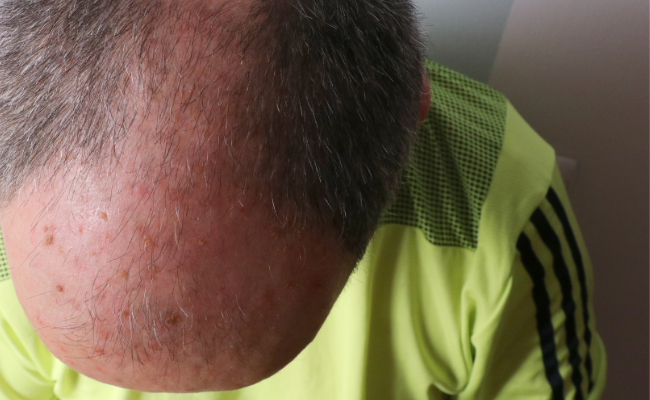How to Treat Actinic Keratoses?
- January 17, 2024
- No Comments

What is Actinic Keratosis?
Actinic keratosis (AK), alternatively known as solar keratosis or senile keratosis, is a prevalent skin condition characterized by the development of rough, scaly patches or lesions on areas exposed to sunlight. These areas typically include the face, ears, neck, scalp, chest, backs of hands, forearms, or any part of the body frequently subjected to ultraviolet (UV) radiation. Although identified as a precancerous condition, not all cases of actinic keratosis progress to skin cancer. Despite this, it remains crucial to address and treat these lesions promptly to prevent potential complications.
Actinic keratosis (AK), also referred to as solar keratosis, manifests as rough, scaly patches on the skin and falls under the category of a precancerous condition. If left untreated, AK poses the risk of evolving into skin cancer, particularly squamous cell carcinoma. Timely intervention is paramount to avert the potential malignant transformation of these skin abnormalities. Neglecting the prompt management of actinic keratosis may lead to the development of more severe complications, emphasizing the importance of proactive measures in addressing this precancerous skin condition.
Why is it Important to Treat Actinic Keratosis?
Actinic keratosis is a result of prolonged sun exposure, leading to the accumulation of DNA damage in skin cells. UV radiation is a major contributor to the development of these lesions, and individuals with fair skin, light-colored eyes, and a history of sunburns are at a higher risk. If left untreated, actinic keratosis can progress to squamous cell carcinoma, a type of skin cancer. Regular monitoring and timely intervention are essential to prevent the malignant transformation of these precancerous lesions.
How to Identify Actinic Keratosis?
Actinic keratosis lesions typically appear as rough, scaly, or crusty patches on the skin. They may be red, pink, flesh-colored, or a combination of these shades. The texture of the patches can range from dry and rough to hard and wart-like. Some lesions may be easier to feel than to see. Actinic keratosis often presents multiple lesions in the affected areas, and they may vary in size. Regular skin examinations, especially for individuals with a history of sun exposure, are crucial in identifying these precancerous lesions.
Treatment Solutions for Actinic Keratosis:
- Fluorouracil (5-FU): This topical chemotherapy agent works by interfering with the DNA synthesis of abnormal cells, leading to their destruction. It is typically applied to the affected skin once or twice daily for a specified period.
- Imiquimod: This immune response modifier stimulates the body's immune system to recognize and eliminate abnormal cells. It is available as a cream and is applied to the affected area several times a week for a prescribed duration.
- Liquid Nitrogen: Cryotherapy involves freezing the affected skin with liquid nitrogen, causing the abnormal cells to break down and eventually slough off. This is a common and effective in-office procedure.
- Photosensitizing Agent and Light Exposure: Photodynamic Therapy (PDT) involves applying a photosensitizing agent to the skin, which is then activated by exposure to a specific wavelength of light. This process selectively destroys abnormal cells while minimizing damage to surrounding healthy tissue.
- Electrosurgery: Electrodessication and Curettage (ED&C): This procedure involves scraping off the affected skin with a curette (a sharp instrument) and then using an electric current to destroy any remaining abnormal cells. It is often used for thicker lesions.
- Laser Therapy: Carbon Dioxide (CO2) Laser: The CO2 laser is used to vaporize the abnormal cells in the affected area. This precise method can be especially beneficial for treating individual lesions.
Benefits of Treating Actinic Keratosis:
- Prevention of Skin Cancer: Timely treatment of actinic keratosis helps prevent the progression to squamous cell carcinoma, reducing the risk of developing skin cancer.
- Improved Aesthetics: Treating actinic keratosis can enhance the appearance of the skin by eliminating rough, scaly patches and promoting smoother, healthier skin.
- Reduced Discomfort: Actinic keratosis lesions can cause discomfort, including itching and tenderness. Treatment helps alleviate these symptoms, improving the overall comfort of affected individuals.
- Enhanced Quality of Life: By addressing actinic keratosis, individuals can enjoy a better quality of life, free from the physical and emotional burden associated with precancerous skin lesions.
- Preventive Measures for Recurrence: Treating actinic keratosis often involves adopting preventive measures, such as sun protection strategies and regular skin examinations, to reduce the likelihood of recurrence.
Comments (0)